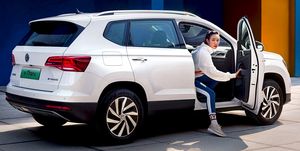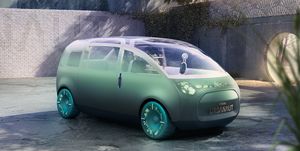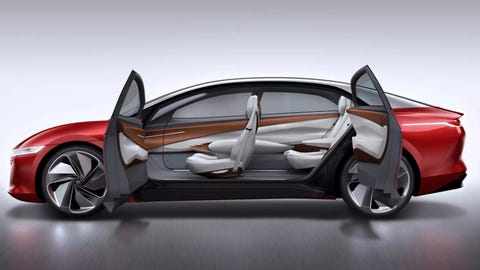Volkswagen has revealed plans to set aside more plants for EV production in the coming decade, amid a greater electric-vehicle development push. Specifically, the automaker plans to convert two existing plants in Hanover and Emden in Germany to EV production, adding greater clarity to its plans for the ID brand. The company has also shared new EV model details.
When it comes to specific EV models, Volkswagen now plans to build the production version of the ID Buzz in Hanover, alongside three other battery-electric SUVs for its other brands. The retro-shaped MPV was among the first battery-electric models from Volkswagen to be green-lit for production, and has been shown to the public in recent years at several auto shows alongside cargo variants also expected to reach production soon.
Volkswagen is also in the process of converting its factory in Emden to EV production — something that has been hinted in recent months. In addition to building the ID.42 electric sport utility, this plant will also produce a four-door electric model called the Volkswagen Aero1.
Note this model is not being referred to as an ID-branded model, so we expect the sedan to be a global model meant for a variety of markets. Not all would get the other ID models. Volkswagen says the four-door will enter production in Emden, white Passat production shifts to Bratislava, Slovakia.
“At the Volkswagen’s brand plant in Emden, the transformation is also progressing rapidly: while the construction work for the switch to electric mobility is fully on track, the second electric model for the site has now been defined,” the automaker disclosed. “In addition to the ID.42, the four-door all-electric Volkswagen Aero1 is scheduled to be manufactured there from 2023.”
What could such an electric four-door model look like?
We expect it could be the production version of the ID Vizzion sedan concept the automaker showed in March 2018, seen above. It previews a large electric sedan expected to target a segment just below the Tesla Model S.
VW has already green-lit the 2018 ID Vizzion concept back in spring, 2018, promising it by 2022. But it’s likely that those plans (alongside ID.3 delays) have been pushed back a year due to the pandemic, and it will now enter production a year later. The ID Vizzion concept shown at the Geneva show promised a monster battery pack with 111 kWh on tap. That’s good enough for a 400+ mile range on a full charge with a dual-motor setup — a 150-kW motor driving the rear wheels and a 75-kW motor driving the front wheels.
The Volkswagen Aero1 branding (as opposed to ID) would make sense for a number of markets, including China, where VW has been present for almost 40 years but ID remains a relatively new and unknown item. And it would also occupy a spot above smaller and less expensive models from the budget-minded ID lineup, which offers buyers a variety of inexpensive EVs like the ID.3 and ID.4.
We don’t expect the production sedan to be as large or heavy as the Phaeton, or the Model S for that matter, but it certainly could be a bit larger and longer than the Passat. This avoids executive-class positioning and pricing of competitors like the Tesla Model S and the Mercedes-Benz EQS, while offering a more upscale battery-electric experience with plenty of range.
The automaker also announced it is investing 73 billion euros on electrification, digital technology and hybrid powertrains over the next five years, boosting investments in research and development to 50 percent from 40 percent of the Volkswagen Group’s total investments, adding up to about 150 billion euros.
Hertbert Diess, Volkswagen Group CEO, stressed the focus on investment in software.
“Having set the course for a battery-electric future in the Volkswagen Group early on, we are now a global leader with our electric platforms and a broad range of electric vehicles,” Diess said. “In the coming years, it will be crucial to also reach a leading position in car software in order to meet people’s needs for individual, sustainable and fully connected mobility in the future. To that end, we have doubled our digitalization spend.”
Source: Read Full Article






